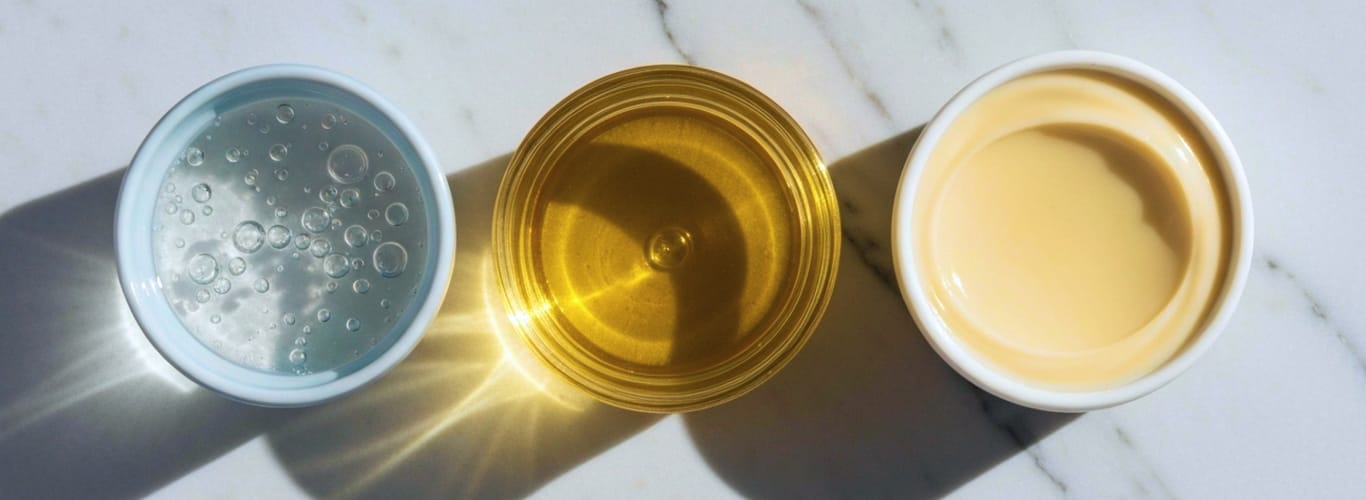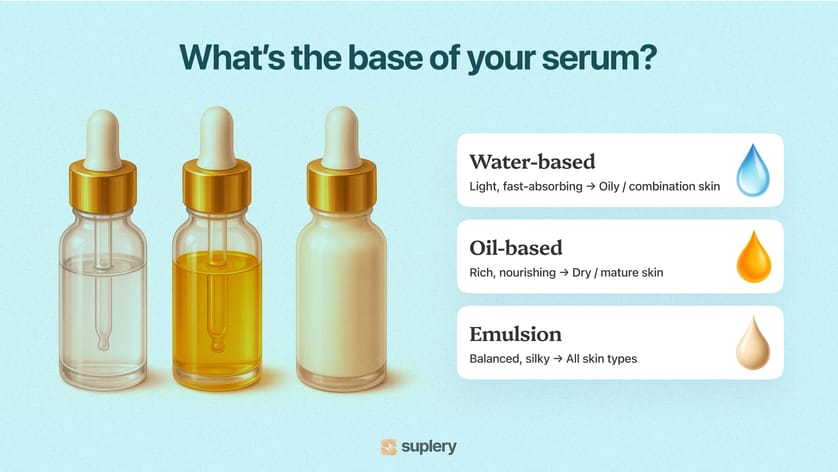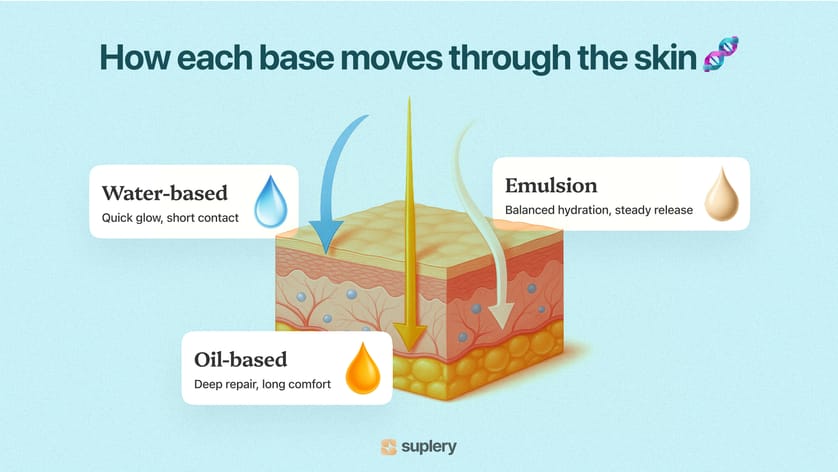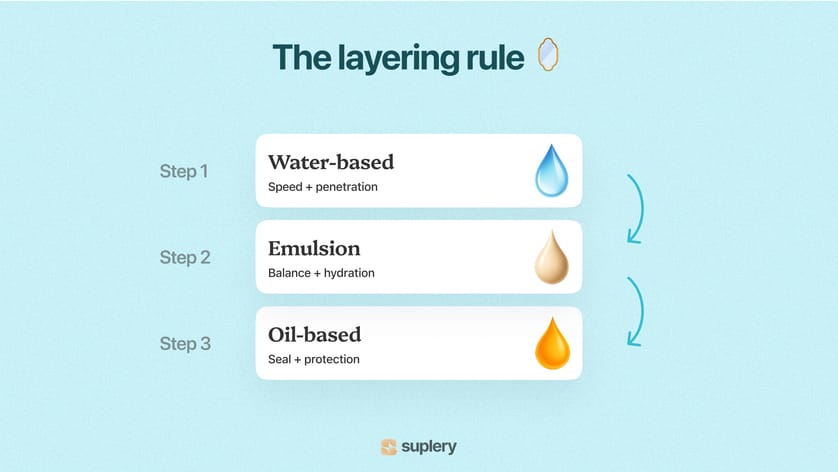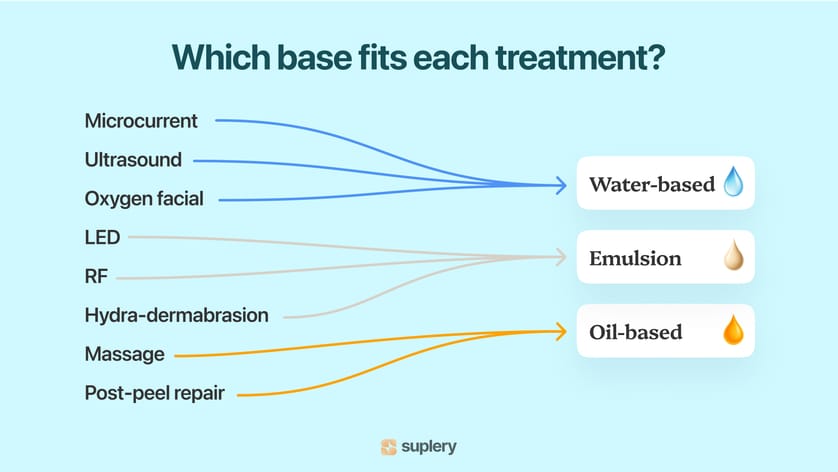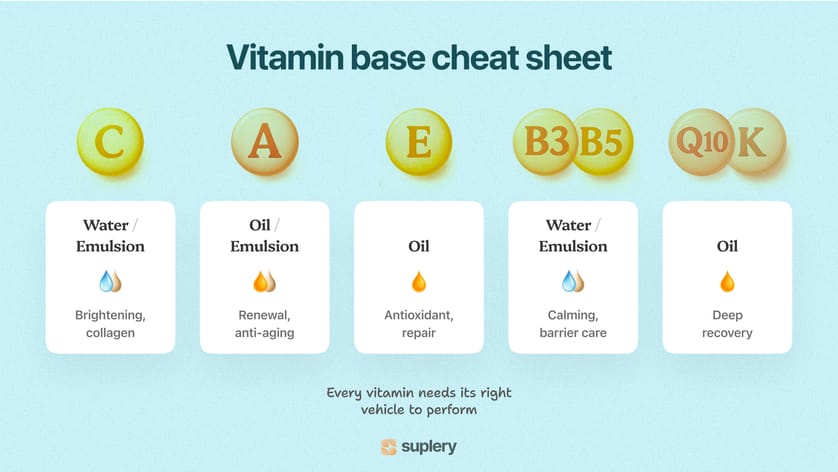Water vs oil vs emulsion: a pro guide to vitamin delivery
Every serum thinks it’s special.
Bright bottle, scientific font, promises of “24-hour glow.” But open two — both with Vitamin C — and you’ll see the truth. One glides, one stings. One performs, one oxidizes before brunch.
Behind every glow or fail is the same story: the сosmetic base.
In professional cosmetics, the base — the water, oil, or emulsion that carries your active ingredients — decides everything: how the formula feels, how deeply it penetrates, how stable it stays, and how your client’s skin responds. The molecule may be identical, but its journey through the skin barrier can look completely different.
The best formulas don’t just contain vitamins; they engineer how those vitamins travel, release, and transform the skin — from barrier repair to anti-aging support.
This guide breaks down the real-world science behind water vs oil vitamins in cosmetics — how each system behaves, which skin types (from oily to mature skin) they flatter most, and how pros can use that knowledge to craft results with precision and personality.
You’ll also find a clear guide on how different procedures align with each base, which vitamin forms deliver best results, and how to read formulations and packaging like a chemist — turning every product choice into a strategic decision.
What is a base (vehicle) — and why it matters
In cosmetic chemistry, a base (or vehicle) is more than just the “texture” of a product — it’s the delivery environment that determines how an active behaves once it touches the skin.
Think of the base as the transport system for your vitamins: it defines their speed, depth, comfort, and stability. Even the most potent molecule won’t work as intended if the vehicle doesn’t match the skin type, service, or goal.
The three core base types
1. Water-based💧
- Feels like a splash of lightweight hydration — fast-absorbing, refreshing, and never sticky, perfect for water-based serums that absorb quickly and leave no oily residue.
- Ideal for oily or combination skin types and multitasking skincare routines (oxygen facials, microcurrent, ultrasonic infusion).
- Works beautifully with devices — water conducts electricity, while oils block it, ensuring maximum absorption of actives.
- Speeds up delivery of ingredients, though high-acid formulas (like pure ascorbic acid) can tingle or irritate dehydrated skin.
- Typical vitamins: C, B3, B5 — great for improving uneven skin tone and restoring intensive hydration.
Water-based formulas slip through tiny aqueous channels between skin cells — tunnels that open when the skin is hydrated. That’s how hydrophilic vitamins like C or B3 reach the upper layers fast, boosting radiant glow and supporting collagen production for a more youthful complexion.
💡 Pro insight:
Pure Vitamin C is a powerhouse for brightening and collagen production, but it’s also a diva — unstable in water and easily oxidized (studies show up to 30 % loss in just three days).
Niacinamide is the opposite: calm, stable, and flexible. It stays effective in almost any formula and helps balance oil while supporting the skin’s barrier and preventing moisture loss.
2. Oil-based🧴
- Rich, silky, and designed to lock in moisture, prevent moisture loss, and rebuild the skin’s barrier.
- A dream for dry, sensitive, or mature skin — especially when the complexion feels dull or over-exfoliated. These formulas help smooth fine lines and deeply nourish for a youthful complexion.
- Penetrates more slowly but provides deeper hydration, targeting the deeper layers of skin and offering lasting anti-aging comfort.
- Typical vitamins: A, E, K — ideal for oil-based formulas that restore elasticity and support collagen production.
Oil-based systems move through the skin’s lipid matrix, the fatty structure that holds cells together. They blend perfectly with sebum and carry lipophilic vitamins like A and E deeper, enhancing elasticity, glow, and resilience.
3. Emulsion (hybrid) systems 🫧
- The best of both worlds: water for freshness, oil for nourishment.
- Feels silky, adaptive, and suits every skin type — from oily to dry, offering balanced intensive hydration and comfort.
- Lets multiple actives coexist safely (think Vitamin C + E or Niacinamide + Panthenol) while helping lock in moisture and strengthen the skin’s barrier.
- Typical vitamins: complexes and encapsulated blends for enhanced absorption and smoother texture.
Emulsions hydrate first, then seal — the water phase plumps and softens, while the oil phase locks it all in. Two steps: entry + protection, reaching the deeper layers of skin for calm, lasting glow.
💡 Pro insight:
Lamellar emulsions are next-generation creams that copy the structure of the skin’s own lipids.
Instead of mixing water and oil randomly, they build thin, layered sheets — like tiny “bricks” that fit perfectly into the skin barrier.
Because of this, they hold moisture far better (almost twice as much as standard creams), reduce water loss, and keep the surface smooth and elastic — ideal for maintaining youthful complexion and deeper hydration.
Why this matters to pros
- Speed vs. comfort: water brings instant glow and fast hydration; oil keeps results deep and long-lasting.
- Tolerance: even a great vitamin can backfire if the base doesn’t fit the skin type or specific skin concerns.
- Tools: water-based products pair perfectly with devices; oil-rich bases protect and rebuild the skin’s protective barrier after exfoliation or restorative care.
- Client perception: texture defines feel, and feel defines trust — clients fall in love with results that feel as good as they look.
In skincare, actives build results — but bases build reputation.
Smart skincare: how delivery systems work ⚙️
If the base is the vehicle, the delivery system is the GPS — it decides how fast, how deep, and how safely your actives reach the deeper layers of skin.
Without it, even the strongest serum can oxidize, irritate, or fade before it starts working — especially when specific skin concerns like dehydration or uneven tone require targeted solutions and precision.
Liposomes, nanoemulsions, microcapsules, gel matrices, and solid lipid nanoparticles don’t make a bad formula good — but they make a good one smarter. These systems control release, enhance maximum absorption, and keep actives performing exactly where and when the skin needs them most, improving texture, clarity, and long-term youthful complexion.
But delivery isn’t just chemistry — it’s also method.
In professional treatments, skin gets pushed, warmed, or awakened to help actives go further. Here’s how:
- Exfoliation — acids or microdermabrasion sweep away the dead layer, opening micro-pathways for actives to enter.
- Heat — steam, warm towels, or thermal masks soften the lipid barrier, increase circulation, and promote intensive hydration.
- Electric current — iontophoresis or microcurrent push charged molecules deeper, right where they can work.
- Ultrasound — gentle sound waves create temporary openings between cells, letting serums slide in effortlessly.
- Cryotherapy — cold locks everything in, sealing actives and calming post-treatment skin.
- Massage or vacuum — mechanical pressure boosts microcirculation and helps distribute ingredients evenly.
- Microneedling or nanoneedling — tiny channels in the epidermis create direct entry points for high-value actives.
- Light and laser therapy — energy-based tools activate cells and improve permeability without breaking the barrier.
- Oxygen or vacuum infusion — pressurized air streams or hydro-systems push serums deep while cleansing the surface.
Together, chemical design and procedural delivery form a complete strategy: one builds precision inside the formula, the other opens the door for it to perform.
The goal is always the same — to make sure every active reaches its target in the deeper layers, not just where it’s applied.
Choosing base and delivery system
Every skin speaks a different language — and your formula is the translator.
Choosing the right base and delivery system isn’t chemistry trivia; it’s the real art of balance — between speed and comfort, depth and control, sensation and result.
A water-based serum brings that instant “glass-skin” clarity and featherlight feel, improving maximum absorption for surface radiance.
An oil-based emulsion slows things down, builds resilience, and locks in moisture, preventing moisture loss and smoothing fine lines for a youthful complexion.
Knowing when to switch between them turns a simple product into a performance — one that fits every client, every mood, every specific skin concern.
Client needs and skin behavior 👩🔬
Oily or acne-prone skin wants to breathe — it thrives on light, water-rich textures that don’t clog pores or interfere with device conductivity. These bases allow maximum absorption and help balance oil for clear, refined texture.
Dry or sensitized skin needs a hug — rich, lamellar emulsions that lock in moisture, rebuild the barrier, and deliver intensive hydration deep into the deeper layers of the skin.
Mature skin needs patience — oil-based serums loaded with retinol, Q10, or antioxidants that travel deeper, firm longer, and help repair fine lines while maintaining hydration and elasticity.
Post-procedure or reactive skin whispers “go slow.”
Here, encapsulated actives in barrier-mimicking emulsions bring calm, hydration, and comfort instead of irritation — a gentle fix for even the most delicate skin concerns.
💡 Pro insight: The skin always tells you what it needs — sometimes through texture, sometimes through tension. Listen to the glide, not the label — and you’ll solve your client’s concerns before they even name them.
Depth and effectiveness 💆♀️
The deeper an active travels, the calmer the surface should feel — and the stronger the concentration, the more control the formula needs.
Water-based systems drive hydrophilic vitamins like C, B3, and B5 through micro-channels fast — bright, refreshing, and perfect for surface radiance. These systems ensure maximum absorption and quick results for specific skin concerns like dull tone or dehydration. But high concentrations can sting or destabilize the formula — they need precision and short contact time.
Oil and emulsion systems move A, E, and Q10 through the skin’s lipid layers — slower, deeper, steadier, and ideal for smoothing fine lines and preventing moisture loss.
They handle stronger doses better, wrapping actives in comfort and building long-term resilience instead of irritation — helping maintain firmness and a youthful complexion.
Nanoemulsions and liposomes balance both worlds, helping actives travel quietly across the barrier at controlled concentrations — no stress, no flare-ups, just results that last and reach the deeper layers of the skin.
That’s why a serum can feel featherlight yet work like an overnight treatment — when the dose, base, and delivery are in sync.
➡️ Water = speed. ➡️ Oil = strength. ➡️ Emulsion = balance.
Speed and service rhythm ⚡
Every treatment has its rhythm — and texture sets the tempo.
Water, oil, and emulsion aren’t just textures — they’re layers of strategy.
- Fast rituals — pre-event facials, express glows, post-flight resets — live on water-based or nanoemulsionformulas. They hit quick, absorb instantly, and deliver targeted solutions with that clean, radiant tension and refreshed feel.
Perfect partners for devices: microcurrent, ultrasound, LED — anything that feeds on conductivity, hydration, and speed.
- Slow rituals — barrier rebuilds, overnight repair, recovery after peels — need emulsions and oils. They slow the rhythm down, lock in moisture, and restore intensive hydration, rebuilding what the day stripped away.
Think encapsulated retinol, coenzyme Q10, or peptide blends — actives that teach the skin endurance instead of instant gratification and help reduce fine lines while improving texture.
And then comes layering — the real choreography of skincare. One product can glow, but layers can transform.
Each base plays its role:
- Water wakes and preps the skin — it opens the gates.
- Emulsion builds the structure — it holds actives where they belong for maximum absorption.
- Oil seals the deal — it keeps everything in, cushions the surface, and prevents moisture loss.
Irritation and tolerance 🌿
Irritation isn’t just about concentration — it’s about control and how the delivery system manages release.
Water-based formulas hit fast, but without protection, strong actives like acids or pure Vitamin C can burn before they brighten.
That’s where encapsulated actives and lamellar emulsions change the game. They trap high-potency ingredients inside lipid or polymer shells, releasing them gradually and buffering the skin from shock while preserving intensive hydration.
Add calmers like panthenol, bisabolol, or ceramides, and even the boldest formulas feel smooth, not sharp. This approach prevents moisture loss, supports the skin’s barrier, and keeps results consistent across different skin types.
It’s not about lowering intensity — it’s about letting the skin keep up, keeping targeted solutions safe and effective for all specific skin concerns.
💡 Pro logic: Encapsulation = precision. Controlled release = tolerance. And tolerance = loyalty — from skin and from clients.
Stability and longevity 🧪
Stability is the quiet science that keeps formulas alive long after the first pump.
It’s what separates a serum that stays golden and powerful from one that turns cloudy, sour, or loses its glow halfway through the bottle.
And while most people blame preservatives, pros know the real enemies are three: light, oxygen, and heat.
Each of them slowly unravels the chemistry — changing texture, color, and performance long before the expiration date.
Here’s how they work — and how smart bases fight back.
☀️ Light — the silent oxidizer
UV exposure breaks molecular bonds in vitamins like C, A, and E, making them lose potency or even form irritants.
Transparent packaging only makes it worse — your actives literally tan before your client does.
Dark glass, airless pumps, and opaque emulsions act like sunscreen for the formula, blocking UV and extending shelf life.
🌬 Oxygen — the quiet thief
Once air hits the formula, oxidation begins. It’s why Vitamin C turns amber, retinol weakens, and your serum’s scent shifts from clean to chemical.
The fix is encapsulated actives and airless systems that limit oxygen exposure.
Even small tweaks — tight lids, minimal headspace, and antioxidant buffers — can save months of performance.
🔥Heat — the invisible accelerator
Every 10°C rise in storage temperature can double the rate of ingredient breakdown.
Heat warps textures, separates emulsions, and speeds up oxidation.
That’s why professional products favor oil-based, anhydrous, or lamellar systems — they handle thermal stress better and keep formulas stable in real-life conditions, not just in the lab.
💡Device compatibility guide
Every device speaks its own language — and only the right base can keep up.
The wrong texture kills conductivity, clogs tips, or burns the skin before results even start.
Here’s how to pair them like a pro 👇
| Device / Method | Best base type |
|---|---|
Microcurrent / EMS / Galvanic | Water-based or nanoemulsion — conduct electricity, glide easily, no oil barrier. |
Ultrasound / Sonophoresis | Water-based or light emulsion — enhances vibration transfer and penetration. |
LED / Light therapy | Any base except oil-heavy — avoid shine that reflects light; emulsions and gels work best. |
Radiofrequency (RF) | Water-rich gels or lamellar emulsions — provide slip and prevent overheating. |
Microneedling / Nanoneedling | Water-based serums or sterile gels — non-comedogenic, device-safe, easily absorbed. |
Cryotherapy / Cold therapy | Oil-based or lamellar emulsions — nourish and seal post-cold exposure. |
Oxygen infusion / Airbrush | Water-based serums — low viscosity for easy misting and even delivery. |
Vacuum / Hydra-dermabrasion | Water-based gels or light emulsions — stable slip, won’t clog tubes or tips. |
Massage (manual / gua sha / roller) | Oil-based or lamellar emulsion — cushion glide, rebuild barrier, lock in moisture. |
Post-peel / Post-laser | Lamellar or encapsulated emulsions — soothe, hydrate, restore comfort, no irritation. |
⚡ The base decides whether your formula works with your tool — or against it.
🧴Homecare and daily flow
Morning is for clarity.
Start with a water-based serum — Vitamin C for brightness, Niacinamide for balance, Hyaluronic acid for that quick, dewy lift.
Follow with a light emulsion or moisturizer, then SPF — always.
Evening is for depth.
Reach for an oil-based serum or an encapsulated retinoid under a soft emulsion.
Let the skin slow down, rebuild, and absorb the calm overnight.
For sensitive or barrier-impaired skin, stay with lamellar emulsions — fewer actives, smarter design. They keep hydration steady and the surface peaceful.
💫 Layering mantra:
Water → Emulsion → Oil for glow that lasts, firmness that stays, and balance that feels effortless.
Vitamin base cheat sheet
The base sets the mood; the form defines the outcome.
| Vitamin | Best in water | Best in oil | Best in emulsion |
|---|---|---|---|
Vitamin C | L‑Ascorbic Acid (fast glow, low‑pH, unstable) | THD Ascorbate, Ascorbyl Tetraisopalmitate (gentle, stable) | SAP, MAP, 3‑O‑Ethyl AA(balanced, brightening) |
Vitamin A | — | Retinol, Retinyl Palmitate (repair; light/air‑sensitive) | Encapsulated Retinal (controlled release, less irritation) |
Vitamin E | — | Tocopherol, Tocopheryl Acetate (antioxidant, barrier support) | C+E+Ferulic systems (synergy, photostability) |
Vitamin B3 | ✅ Water-soluble (stable, calming) | — | Works with panthenol or peptides for smoother texture |
Vitamin B5 | ✅ Water-soluble (hydrating, barrier-supportive) | — | Common in post-procedure creams and masks |
Vitamin K | — | K-Oxide (targets redness, capillary repair) | Often paired with caffeine or peptides |
Coenzyme Q10 | — | ✅ Oil-soluble (anti-aging, antioxidant shield) | Combined with Vitamin E or ceramides for endurance |
💡 Pro tip: When in doubt, layer.
Start with a water-based serum for speed, seal with an oil-rich antioxidant for endurance — and let your client leave glowing and protected.
🔍 Reading the packaging
Once you learn to decode a label, you can tell exactly how a product will behave — before it ever touches your client’s skin.
1. Spot the base in the first few lines
The first three to five ingredients tell you the whole story — no marketing fluff required. Here’s your cheat sheet:
| If you see… | It’s likely a… |
|---|---|
Aqua, Glycerin, Propanediol | Water-based |
Caprylic/Capric Triglyceride, Squalane, Jojoba Oil | Oil-based |
Aqua + Oils + Emulsifiers (Cetearyl Alcohol, Polysorbate, PEGs) | Emulsion |
If the ingredient list doesn’t tell the whole story — check the product documentation.
Professional brands usually include a technical sheet or safety data file (SDS) where you’ll find the base type, pH, viscosity, and even solvent system.
That’s the real map behind the marketing. It shows whether the formula is water-, oil-, or emulsion-based, and helps match it correctly with tools, layering routines, and sensitive-skin protocols.
2. Feel it out
Your fingers can tell what the INCI list won’t.
- Water-based: lightweight, fast-absorbing, perfect under devices or layering routines.
- Oil-based: rich, cushiony, great for massage, barrier repair, or dry-skin clients.
- Emulsion: balanced and silky — the “goldilocks” of textures, suits most skins
3. Look for subtle clues on the label
Sometimes the brand tells you everything — if you know how to listen.
- “Suitable for devices” → usually water or nanoemulsion.
- “Restorative / night use” → oil or encapsulated system.
- “pH 3–4” → acidic vitamin C (L-ascorbic acid).
- “Encapsulated retinol” → a hybrid emulsion with time-release delivery.
🔬In practice: what it all means
Understanding how bases and delivery systems interact is what turns skincare formulas into reliable tools.
Once you recognize how each type behaves — how a water serum conducts, how an emulsion buffers, how an oil seals — you can predict performance before even opening the bottle.
For professionals, this knowledge means fewer surprises and better control:
→ predictable results,
→ consistent client comfort,
→ and smarter product choices across every step — from backbar to homecare.
💡 Pro takeaway:
Master the base, trust the system — and every vitamin will perform exactly as promised.
 Elevate your glow with proven beauty secrets
Elevate your glow with proven beauty secrets
Dive in now for the latest beauty hacks, expert-approved tips, and transformative routines!
Oh no! We couldn’t subscribe you ☹️
Done! You've subscribed 💛
Unsubscribe anytime. Your data is stored for business-to-business communication purposes. See our Privacy policy.
Frequently asked questions
Why do two serums with the same vitamin act so differently?
Because the base and delivery system control how the vitamin travels and how it interacts with different skin concerns. A water-based serum with Vitamin C gives instant brightness and helps stimulate collagen production, but it can oxidize quickly. An oil-based serum releases actives slowly, boosts skin elasticity, and provides long-lasting hydration — same vitamin, completely different experience.
Are water-based formulas always better for oily or acne-prone skin?
Usually yes, but not always. Water-based serums have a lightweight texture that won’t clog pores, keeping acne-prone skin balanced and matte. However, some nanoemulsions or hybrid emulsions can offer the same breathable finish while adding deep hydrationand comfort. It’s all about matching texture and tolerance to the client’s needs.
Can I combine water- and oil-based products in one service?
Absolutely — in fact, that’s often the most effective way to target specific skin concerns. Apply water-based actives first (they absorb quickly and reach deeper layers), then seal them with an oil-based serum or emulsion to lock in moisture and reinforce the protective barrier. This layering mimics the skin’s natural structure and keeps results stable and luminous.
How can I tell if a formula is stable?
Check the details: opaque or airless packaging, added antioxidants (Vitamin E, ferulic acid), and keywords like encapsulated or liposomal. If it’s a clear Vitamin C serum in a dropper bottle, oxidation can cause moisture loss and uneven tone within weeks. Keep it sealed, cool, and dark to preserve its brightening power and anti-aging benefits.
Is an oil base safe for sensitive or acne clients?
It depends on the oil and formulation. Dry, non-comedogenic esters like squalane keep skin soft without congestion, while rich plant oils are better for dry or mature skin. Properly formulated oil-based serums calm sensitivity, smooth fine lines, and help restore the protective barrier — all without breakouts. Balance is key: choose lighter oils for oily skin, heavier blends for barrier repair.
How do delivery systems affect irritation?
Encapsulation and liposomes act as shock absorbers — they buffer intensity and release actives gradually. This makes high-strength retinoids or acids far gentler while maintaining results like smoother texture, even tone, and a youthful complexion. When combined with emollients or ceramides, these systems maintain long-lasting hydration and resilience.
Which base type lasts longer on the shelf?
Oil-based formulas and encapsulated systems win for stability — they protect fragile actives from air and light. Water-based serums, especially those with Vitamin C, are fresher but shorter-lived. Rule of thumb: transparent and citrus-scented formulas should be used quickly; creamy or encapsulated products stay potent longer and help prevent moisture loss and dullness.
What’s the easiest way to train a team on this topic?
Use targeted solutions in real time. Let your team test a water-based serum, an oil elixir, and an emulsion side by side. Discuss how each texture behaves — how water gives instant radiance, oil seals in comfort, and emulsions balance both worlds. Feeling the difference builds understanding faster than any chart — and helps them explain why great formulas feel as good as they look.
Last updated on Oct 16, 2025
A new in-depth guide helping beauty professionals understand how base systems and delivery methods determine the feel, depth, and results of vitamin formulas — and how to choose the right one for every service.
Please share this post
Table of Contents
What is a base (vehicle) — and why it mattersThe three core base typesSmart skincare: how delivery systems work ⚙️Choosing base and delivery system🔍 Reading the packaging🔬In practice: what it all meansFrequently asked questionsNatural vs. synthetic vitamins: what really matters in pro beauty
Clients ask if vitamins are “natural” or “synthetic.” Pros know the truth: what matters is results, stability, and safety in the treatment room. Here’s the real story behind natural vs synthetic vitamins.
Chemistry of beauty
10 min
From stock chaos to profit: 6 salon inventory case studies
See how top salons streamlined inventory, slashed costs, and grew profits. Steal these proven strategies and turn your stockroom into a secret profit weapon.
Inventory management in beauty business
8 min
Salon inventory tips: how to find hidden savings
In the beauty business, we spend 10% to 25% of the revenue or even more on products and materials. Do you ever think that the inventory in stock is a substantial amount of money frozen in products stored in your warehouse?
Inventory management in beauty business
6 min
Unlock FREE bonus material!
Get your hands on "Smart backbar toolkit: printable templates for salon control". Subscribe to our newsletter and receive a link to download it straight to your inbox.
Oh no! We couldn’t subscribe you ☹️
Done! We've sent a link to your Email 📨
Trusted by the best in the beauty industry.
Transform your beauty business with Suplery!
Already enjoying our expert tips? Take the next step and join Suplery to revolutionize your business operations.
Huge range of professional products
One-click checkout after first order
Automated predictive orders
Seamless inventory management
From words to action
Start working with Suplery and explore all the tools and services you need to expand your business
Get started with Suplery24/7 Support
Secure payments
Designed by industry’s experts
